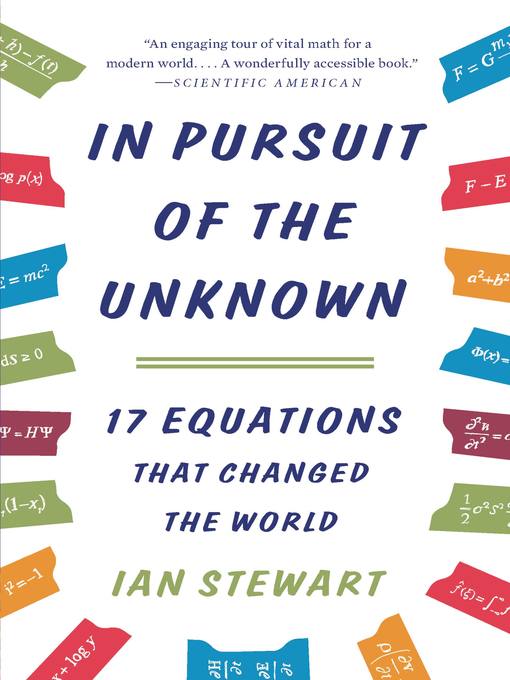Most people are familiar with history's great equations: Newton's Law of Gravity, for instance, or Einstein's theory of relativity. But the way these mathematical breakthroughs have contributed to human progress is seldom appreciated. In In Pursuit of the Unknown, celebrated mathematician Ian Stewart untangles the roots of our most important mathematical statements to show that equations have long been a driving force behind nearly every aspect of our lives.
Using seventeen of our most crucial equations — including the Wave Equation that allowed engineers to measure a building's response to earthquakes, saving countless lives, and the Black-Scholes model, used by bankers to track the price of financial derivatives over time — Stewart illustrates that many of the advances we now take for granted were made possible by mathematical discoveries.
An approachable, lively, and informative guide to the mathematical building blocks of modern life, In Pursuit of the Unknown is a penetrating exploration of how we have also used equations to make sense of, and in turn influence, our world.
-
Creators
-
Publisher
-
Release date
March 13, 2012 -
Formats
-
Kindle Book
-
OverDrive Read
- ISBN: 9780465029747
-
EPUB ebook
- ISBN: 9780465029747
- File size: 4056 KB
-
-
Languages
- English
-
Reviews
-
Publisher's Weekly
January 16, 2012
Stewart (Game, Set, and Math) shares his enthusiasm as well as his knowledge in this tour of ground-breaking equations and the research they supported. “Equations are the lifeblood of mathematics, science, and technology,” allowing scientists, engineers, and even economists to quantify ideas and concepts. Stewart, Warwick University emeritus professor of mathematics, proceeds chronologically, beginning with Pythagoras’ theorem. He opens each chapter with an equation, then summarizes its importance and the technological developments it brought about. Many of the equations are famous, from Maxwell’s equations unifying electricity and magnetism, and of course Einstein’s “E=mc²”, to Schrödinger’s equation and its unhappy cat. Some are broader mathematical concepts rather than equations, from logarithms and calculus to chaos theory. Two surprising inclusions are the math behind information theory, created by Claude Shannon, and the infamous Black-Scholes equation—aka the “Midas” formula, which describes how the price of a stock derivative changes over time (which he implicates in the current financial crisis). Stewart assembles an entertaining and illuminating collection of curious facts and histories suitable for random dipping-in or reading straight through. Agent: George Lucas, Inkwell Management. -
Library Journal
April 15, 2012
In this new work, Stewart (mathematics, emeritus, Univ. of Warwick, UK; The Mathematics of Life) reviews 17 equations from the Pythagorean theorem of ancient times to the Black-Scholes formula of the late 20th century, including Newton's law of gravity and Einstein's theory of relativity in between. He explains the origins of each equation and its initial uses and then goes on to describe ensuing development and newer applications. Stewart's expertise and his well-developed style (enhanced by a nice sense of humor) make for enjoyable reading. Although readers with an already established background in mathematics and its functions will benefit the most, others will find much to enjoy. In some of the chapters, Stewart's treatment of historical origins seems a bit perfunctory. VERDICT Overall, a worthwhile and entertaining book, accessible to all readers. Recommended for anyone interested in the influence of mathematics on the development of science and on the emergence of our current technology-driven society.--Jack W. Weigel, Ann Arbor, MI
Copyright 2012 Library Journal, LLC Used with permission.
-
Kirkus
February 1, 2012
Stewart (Mathematics Emeritus/Warwick Univ.; The Mathematics of Life, 2011, etc.) unravels the secret history of equations that "have been pulling the strings of society, [t]ucked away behind the scenes." The author shows how mathematics has played a crucial role in the "ascent of humanity," but were merely steps in the technological advances that followed. He begins with Pythagoras' Theorem, the essence of which was discovered thousands of years before and laid the basis for navigation and astronomy. He ends with the Black-Scholes Equation, the mathematical formula that created the possibility for computerized derivatives trading and arguably the recent economic meltdown, and urges the need for more regulation of financial markets. Stewart provides clear, cogent explanations of how the equations work without burdening the reader with cumbersome derivations. Instead, he uses them to elaborate his thesis that mathematics, despite its pivotal influence, does not in itself change the world. He gives a fascinating explanation of how Newton's laws, when extended to three-body problems, are still used by NASA to calculate the best route from Earth to Mars and have laid the basis for chaos theory. Throughout, Stewart's style is felicitous and mostly accessible. While the early chapters of the book, which cover trigonometry, calculus and statistics, offer an excellent introduction, the late chapters, which cover quantum, information and chaos theory, require more scientific background to be fully understood. A readable but not simple mathematical guidebook to the labyrinth of mathematics.COPYRIGHT(2012) Kirkus Reviews, ALL RIGHTS RESERVED.
-
Formats
- Kindle Book
- OverDrive Read
- EPUB ebook
subjects
Languages
- English
Loading
Why is availability limited?
×Availability can change throughout the month based on the library's budget. You can still place a hold on the title, and your hold will be automatically filled as soon as the title is available again.
The Kindle Book format for this title is not supported on:
×Read-along ebook
×The OverDrive Read format of this ebook has professional narration that plays while you read in your browser. Learn more here.



